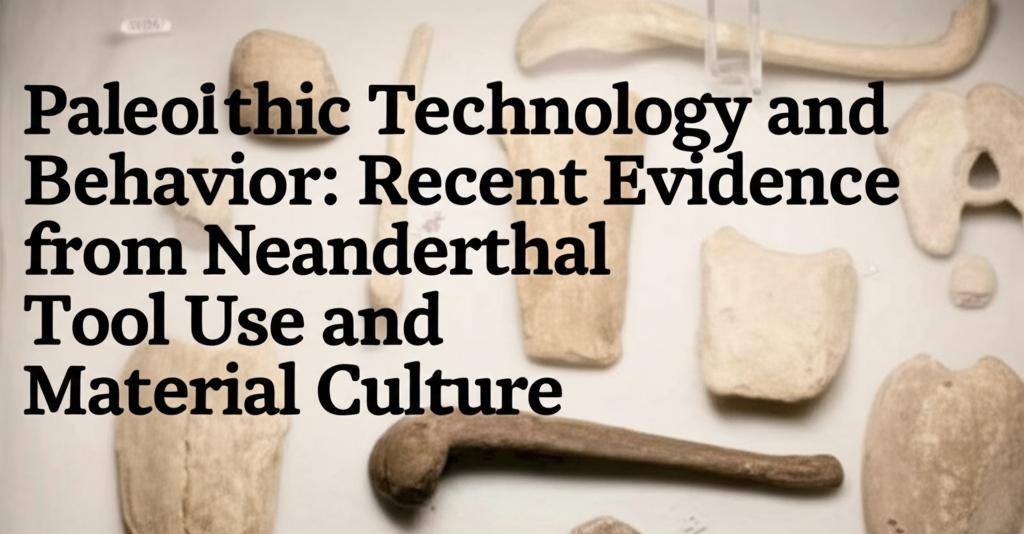Recent discoveries are painting an increasingly complex picture of Neanderthal life during the Paleolithic era, revealing sophisticated technological skills and behaviors that challenge older stereotypes. Evidence from archaeology continues to shed light on their tool use, material culture, and cognitive abilities.
Advanced Toolmaking and Technological InnovationNeanderthals possessed a robust toolkit, traditionally associated with the Mousterian industry, which involved techniques like Levallois flaking to produce sharp flakes from prepared stone cores. However, recent findings push the boundaries of their known technological prowess.
- Complex Adhesives: Groundbreaking research from sites like Le Moustier in France (dating back 40,000 to 120,000 years) has revealed that Neanderthals created multi-component adhesives. Specifically, they mixed ochre (an earth pigment) with bitumen (a component of asphalt) to create glues, likely used to attach stone tools to handles, forming grips. This discovery, dated as the earliest evidence of complex adhesives in Europe, showcases advanced planning, as materials like ochre and bitumen often had to be sourced from distant locations. Similar evidence for birch bark tar production, another complex adhesive requiring controlled heating, has been found in places like the Dutch North Sea (around 50,000 years ago) and Gibraltar (around 65,000 years ago), indicating this was a routine part of their technological repertoire across different regions and environments. This demonstrates complex cognition and problem-solving skills comparable to early Homo sapiens in Africa.
- Stone Tool Techniques: While known for Mousterian and Levallois methods, new evidence suggests Neanderthals' stone tool repertoire was broader and potentially overlapped more with Homo sapiens than previously thought. At Shukbah Cave in the Levant, a Neanderthal child's tooth was found alongside stone tools made using the Nubian Levallois technique, a method previously considered exclusive to Homo sapiens. This finding not only extends the known southern range of Neanderthals but also complicates attempts to distinguish hominin populations solely based on tool types, hinting at possible technological exchange or shared capabilities. Furthermore, the discovery of Quina tools (a specific type of scraper production) dating to ~55,000 years ago in China, a technology previously linked mostly to European Neanderthals, raises intriguing questions about Neanderthal range, technological diffusion, or independent invention by other archaic human groups like Denisovans in Asia.
- Bone Tools: Once thought to be a hallmark of Homo sapiens, sophisticated bone tool use is now clearly documented among Neanderthals. Sites like Chagyrskaya Cave in Siberia (~50,000-60,000 years ago) and Chez-Pinaud in France have yielded hundreds of bone tools, including "retouchers" used for sharpening stone implements, beveled tools, and smoothers likely used for working hides. This indicates that Neanderthals utilized animal resources not just for food but also as raw materials for a diverse toolkit, engaging in complex butchering and hide preparation processes.
Neanderthal material culture extended beyond purely functional tools, suggesting elements of symbolic thought and complex social behaviors.
- Use of Pigments and Ornamentation: There is widespread evidence for Neanderthal use of natural pigments like red ochre and black manganese oxides. Over 70 sites show manganese use, and ochre appears at numerous locations, sometimes found on shells that were transported far from their origin. These pigments might have been used for body painting, decorating objects, or potentially in adhesive recipes. Evidence also points to the collection and modification of items for non-utilitarian purposes, including feathers (especially dark ones), claws, and shells, possibly worn as ornaments. Collections of unusual objects like fossils or crystals have also been found at Neanderthal sites.
- Burial Practices: Evidence suggests Neanderthals intentionally buried their dead, a practice indicating complex symbolic behavior previously unseen in earlier human species. Some burials appear to include grave offerings, such as flowers or ochre, as suggested by findings at sites like Tinshemet Cave in the Levant. Such practices point towards social bonds and potentially ritualistic or symbolic thinking surrounding death.
- Art and Engravings: While still debated, some findings suggest nascent artistic expression. Simple designs incised on bones, stone fragments, and possible cave markings (like the hashtag-like engraving found in Gibraltar) hint at symbolic capacity, though conclusive evidence remains scarce compared to later Homo sapiens art.
Recent research underscores Neanderthal adaptability and behavioral sophistication.
- Hunting and Diet: Far from being simple scavengers, Neanderthals were skilled hunters and likely apex predators in their environments. They hunted large game like red deer, reindeer, horses, and bison, possibly using ambush tactics with thrusting spears. Evidence also shows they exploited a wide range of resources based on availability, including smaller mammals (rabbits, turtles), birds, marine resources (mollusks, seals, fish in coastal areas), and plant foods. Their varied diet indicates adaptability and planning. Micro-wear on teeth and residues on tools confirm the processing and likely consumption of plants, contributing to their overall subsistence.
- Social Life and Cognition: Neanderthals controlled fire, used hearths for warmth and cooking, and maintained campsites, some possibly used seasonally or for longer durations. The complexity apparent in their toolmaking, adhesive production, resource procurement (requiring planning and travel), and potential symbolic behaviors (burials, ornamentation) collectively points to significant cognitive abilities, including planning depth, problem-solving, and likely complex communication. Evidence of healed severe injuries on some skeletons has also led to suggestions of social care within groups. Findings like shared tool technologies across sites occupied by different hominin groups (as seen in the Levant) suggest potential cultural exchange and interaction networks.
In conclusion, contemporary research consistently reveals Neanderthals as a technologically adept and behaviorally complex group within the Paleolithic world. Their mastery of materials, innovative tool designs, use of adhesives, and engagement in symbolic practices demonstrate advanced cognitive abilities and adaptability, challenging outdated notions and providing a richer understanding of human evolution during this period.

